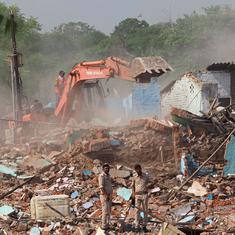Sri Lanka is once again facing a significant marine environmental crisis, as tiny plastic pellets, commonly known as nurdles, have begun washing ashore along the island’s northern coastline.
This time, the pollution is linked to the sinking of the Liberia-flagged container ship MSC ELSA 3 off of Kerala, India. The unfolding incident has triggered fears of a repeat of the X-Press Pearl disaster in 2021, the worst maritime disaster to have occurred in Sri Lanka, significantly impacting marine ecosystems and coastal communities.
According to the Indian Coast Guard, the MSC ELSA 3, carrying 640 containers including hazardous cargo, sank on May 25, roughly 38 nautical miles off the Kerala coast. The cause was reportedly a failure of its ballast system.
Indian authorities confirmed the vessel was loaded with an estimated 85 metric tonnes of diesel and 367 metric tonnes of furnace oil, in addition to at least 13 containers of dangerous substances such as calcium carbide. All 24 crew members were safely rescued by Indian Coast Guard and Navy teams.
While Indian authorities were able to initially contain an oil spill, the environmental fallout soon escalated. Plastic nurdles released from sunken containers began appearing on beaches in southern India, and by June 11, ocean currents driven by strong gusts of southwest monsoon winds carried them toward Sri Lanka’s northern shores, raising serious concerns among marine biologists and local communities.
Fresh environmental fallout
“We’ve begun cleaning efforts and are evaluating coordinated response actions,” said Padma Abeykoon, additional secretary at the Ministry of Environment. With strong monsoon winds forecast for the coming days, she noted that ocean currents may bring even more pollutants ashore.
According to Abeykoon, Indian authorities had alerted Sri Lanka about the possibility of debris from the sunken vessel drifting toward its shores, depending on ocean current patterns. The plastic pellets first arrived on the northern islands and reached the Mannar coast within a day, continuously washing up along Sri Lanka’s southern-facing beaches.
One of the earliest reports from Sri Lanka came from Lahiru Walpita, a birdwatcher in Mannar, who observed the nurdles during his routine early morning seabird monitoring. “On June 12, I noticed strange white pebbles scattered across the Mannar beach. A closer look revealed they were plastic nurdles, something I sadly recognise from the X-Press Pearl spill,” Walpita said.
Walpita initially assumed the rough seas had opened up a remnant of X-Press Pearl, but as he discovered 20 25-kg bags of nurdles strewn across a 2-km stretch of the beach in Mannar, he realised something was wrong. Out of these, only two bags were damaged, and others were in perfect shape, Walpita told Mongabay.

Walpita also observed crows and an egret investigating the pellets but hadn’t consumed them. “However, seabirds, like little terns and bridled terns, feed off the ocean surface while in flight and I fear they could mistake these pellets for food as they have little time to observe,” he warned.
The breeding season for these species, especially on tiny islands nearby in Adam’s Bridge Marine National Park, runs from May to September, and Walpita fears the nurdle invasion could disrupt their reproductive cycles.

Temporary ban
Meanwhile, Indian authorities imposed a temporary fishing ban within 20 nautical miles of the MSC ELSA 3 wreck to mitigate risks from hazardous cargo.
One of the most concerning chemicals on board was calcium carbide, which reacts violently with water to release acetylene – a highly flammable and potentially explosive gas – and produces caustic substances harmful to marine life.
“The ship sank about 300 nautical miles from Sri Lanka, so we don’t anticipate immediate chemical contamination threat for Sri Lankan waters,” said Jagath Gunasekara, general manager of Sri Lanka’s Marine Environment Protection Authority. “However, we are conducting continuous water quality tests and have activated the National Oil and Hazardous Noxious Substances Spill Contingency Plan to remain prepared,” he added.

Adding to the urgency, Indian authorities are battling another maritime emergency just two weeks after the ELSA 3 incident.
On June 7, the Singapore-flagged container ship MV Wan Hai 503 caught fire following multiple explosions, approximately 88 nautical miles off the coast of Kerala. The vessel, carrying more than 2,128 metric tonnes of fuel and numerous containers with hazardous materials, poses a potentially greater environmental risk than ELSA 3. As of June 18, Indian Coast Guard reports indicated that the fire was under control. The drifting vessel has since been secured and successfully towed away.

Nurdle spill
The nurdles are highly persistent in the marine environment, as they can absorb toxic chemicals and enter the food chain, posing a risk to marine life and potentially humans as research on the aftermath of X-Press Pearl disaster proves.
The parallels of these disasters with the X-Press Pearl disaster are striking. The 2021 incident released billions of nurdles into the Indian Ocean, contaminating beaches for months, killing marine organisms and disrupting fishing livelihoods.
One silver lining is that a lot of research was conducted following the X-Press Pearl disaster, and this can be informative in tackling the ongoing episode of the nurdle pollution, Gunasekara said.
Even today, Sri Lanka is fighting for adequate compensation, with legal proceedings dragging on in international courts. The echoes of that catastrophe now serve as a grim warning: unless stronger regional protocols and maritime safety measures are enforced, the region could be doomed to repeat history.
This article was first published on Mongabay.










